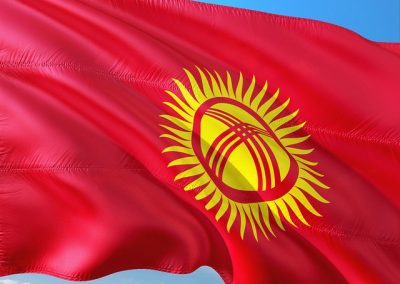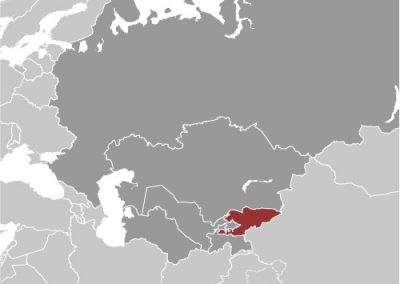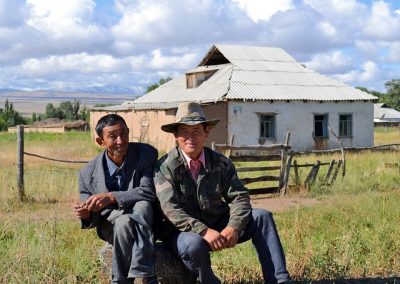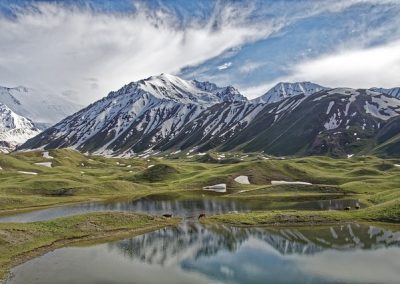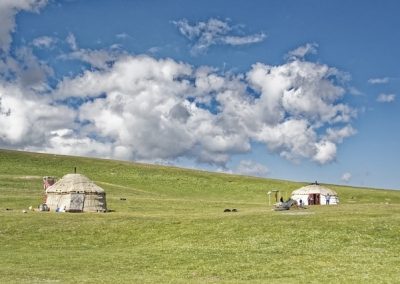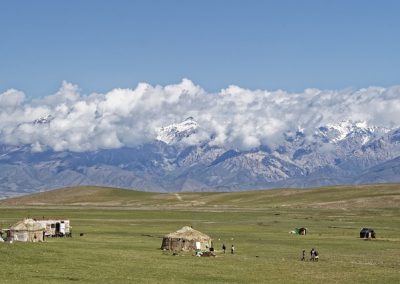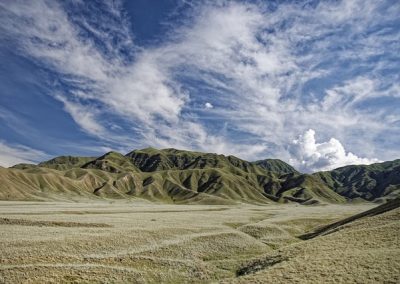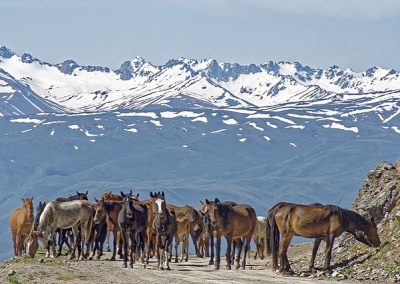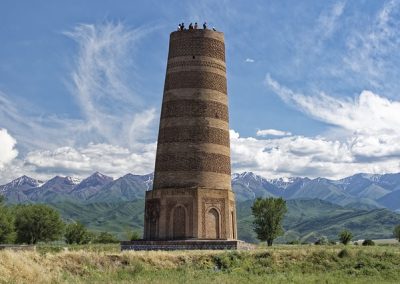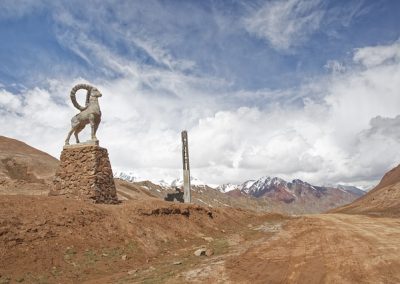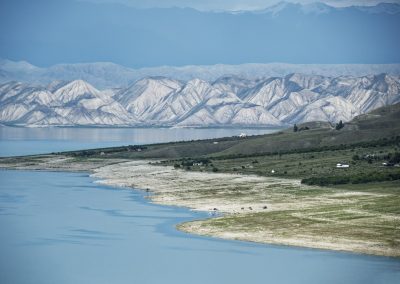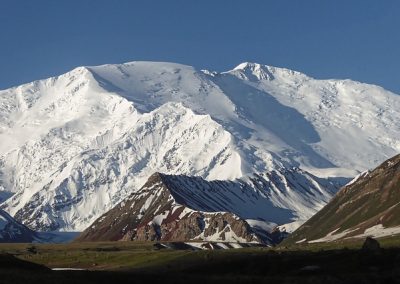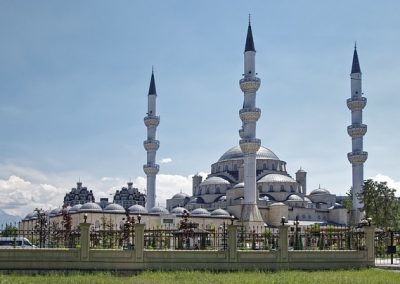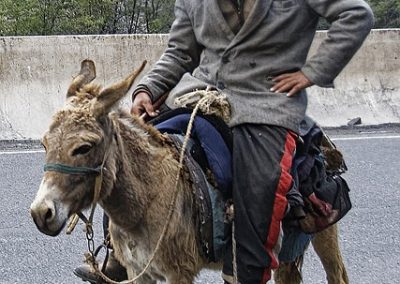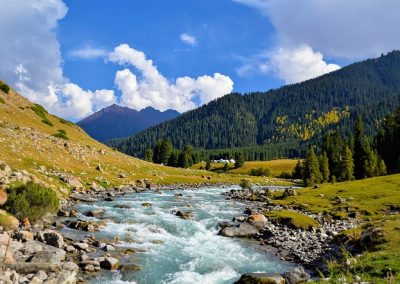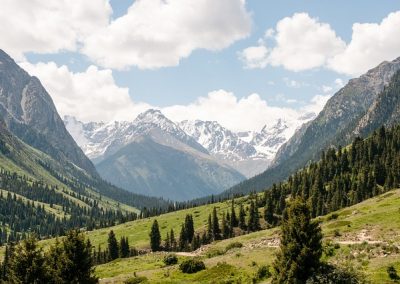Kyrgyzstan (Kyrgyz Respublikasy (Kyrgyz); Respublika Kirgizstan (Russian) (Kyrgyz Republic))

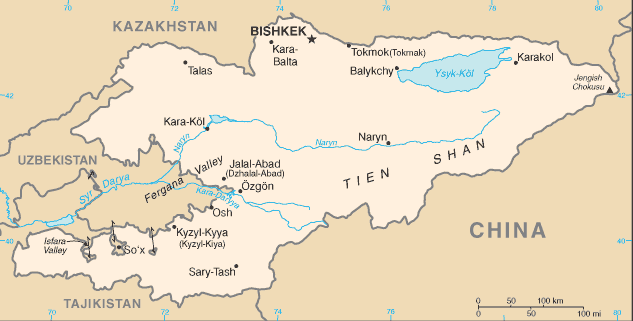

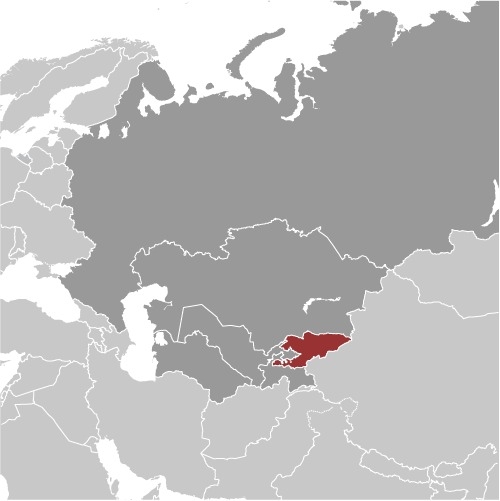
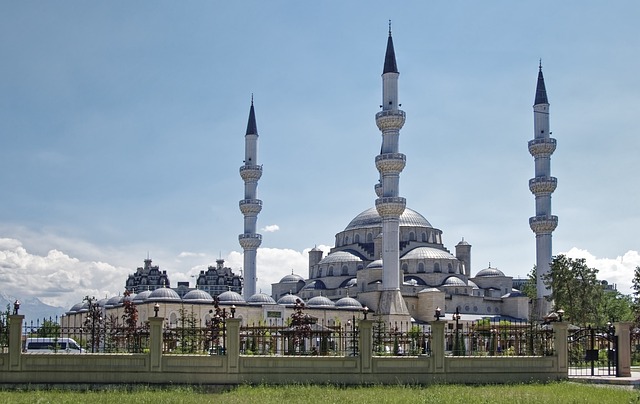
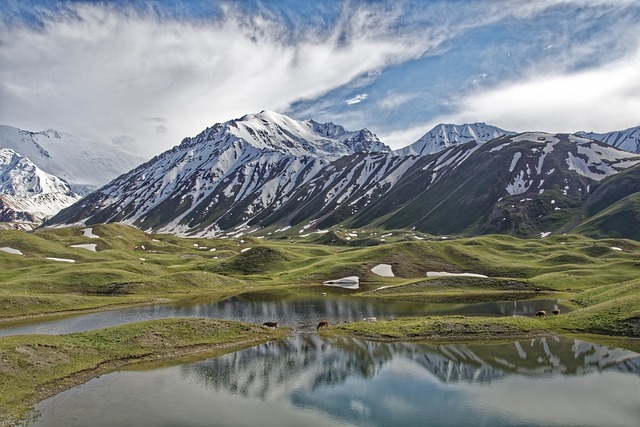
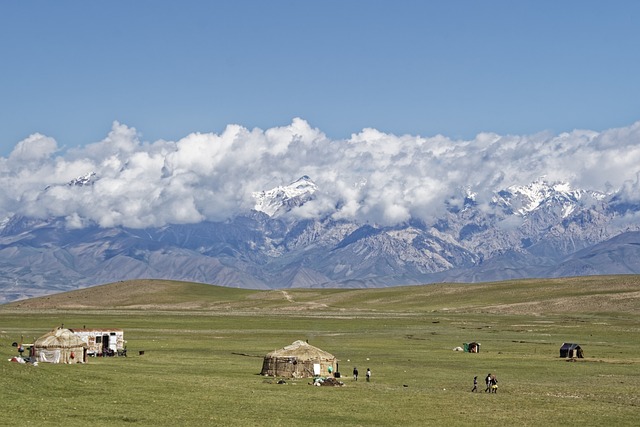
Capital: Bishkek
Population (Estimated July 2012): 5,496,737
Area: 199,945 km2 or 77,199 mi2
Currency: Kyrgyzstan Som (KGS)
Official Language: Kyrgyz; Russian
Political Information: Parliamentary Republic
Official Religion: No Official Religion (approximately 75% of the population are Muslim, 20% are Russian Orthodox and 5% have other religious beliefs).
Highest Mountain: Jengish Chokusu (Victory Peak) at 7,439m or 24,406ft
Largest River:
Time Zone (GMT/UTC): +6:00
Wildlife:
Counties/Provinces/States: 7 provinces (oblastlar, singular – oblasty) and 1 city* (shaar); Batken Oblasty, Bishkek Shaary*, Chuy Oblasty (Bishkek), Jalal-Abad Oblasty, Naryn Oblasty, Osh Oblasty, Talas Oblasty, Ysyk-Kol Oblasty (Karakol)
Leaders: President Almazbek Atambayev, with Prime Minister Omurbek Babanov.
Additional: Gained independence from the Soviet Union on the 31st of August 1991.
Kyrgyzstan
Kyrgyzstan, officially the Kyrgyz Republic, is a landlocked nation situated in Central Asia. It shares borders with Kazakhstan to the north, Uzbekistan to the west, Tajikistan to the south, and China to the east. Bishkek serves as the capital and largest city.
The country boasts a diverse population comprising Kyrgyz, Uzbeks, Russians, and other ethnic groups, each contributing to its rich history and culture. Following its independence from the Soviet Union in 1991, Kyrgyzstan has endeavoured to establish a stable and prosperous nation. The country is renowned for its breathtaking natural landscapes, including majestic mountains, pristine lakes, and verdant valleys.
Kyrgyzstan’s cultural heritage is equally impressive, featuring traditional crafts, music, and cuisine that reflect its multicultural society. Visitors to Kyrgyzstan can partake in a variety of activities, from outdoor pursuits such as trekking and horse riding to exploring ancient historical sites. The warmth and hospitality of the Kyrgyz people further enhance the visitor experience.
With its unique combination of natural splendour and cultural wealth, Kyrgyzstan remains a relatively undiscovered destination with significant tourism potential.
Summary
- Kyrgyzstan is a landlocked country in Central Asia, known for its stunning natural landscapes and rich nomadic heritage.
- The geography of Kyrgyzstan is dominated by mountains, including the Tien Shan range, and the climate varies from subtropical in the Fergana Valley to polar in the high mountains.
- The history of Kyrgyzstan is marked by a mix of nomadic traditions, Soviet influence, and independence since 1991, with a diverse culture influenced by Kyrgyz, Russian, and Uzbek traditions.
- Kyrgyzstan’s economy relies on agriculture, mining, and remittances from Kyrgyz migrants working abroad, with potential for growth in tourism and hydropower industries.
- Tourism in Kyrgyzstan is growing, with attractions including the ancient city of Osh, Lake Issyk-Kul, and opportunities for trekking, horseback riding, and cultural experiences with nomadic communities.
- The political landscape of Kyrgyzstan has been marked by periods of instability and transition, with a parliamentary system and recent protests leading to changes in government.
- The future prospects for Kyrgyzstan include potential for economic development through tourism, hydropower, and regional trade, alongside challenges in political stability and ethnic relations.
Geography and Climate of Kyrgyzstan
Geographical Features
The country is also home to numerous glaciers, lakes, and rivers, including the famous Issyk-Kul Lake, one of the largest alpine lakes in the world.
Outdoor Activities
The diverse geography of Kyrgyzstan offers a wide range of outdoor activities, from trekking and mountaineering to skiing and white-water rafting. The climate in Kyrgyzstan varies depending on the region, with the low-lying Fergana Valley experiencing hot summers and mild winters, while the mountainous areas have a continental climate with cold winters and mild summers.
Natural Beauty and Challenges
The country is also prone to earthquakes and landslides due to its mountainous terrain. Despite these challenges, the natural beauty of Kyrgyzstan continues to attract visitors from around the world, who come to explore its pristine landscapes and experience its unique culture.
History and Culture of Kyrgyzstan
The history of Kyrgyzstan dates back thousands of years, with evidence of human habitation found in the region as far back as the Paleolithic era. Over the centuries, the area that is now Kyrgyzstan has been inhabited by various nomadic tribes and has been part of several empires, including the Mongol Empire and the Russian Empire. In 1936, it became a Soviet republic until gaining independence in 1991.
The culture of Kyrgyzstan is a rich tapestry of traditions, customs, and folklore that have been passed down through generations. The country is known for its traditional crafts such as felt-making, weaving, and pottery, as well as its vibrant music and dance traditions. The Kyrgyz people are also famous for their hospitality and warmth towards guests, with a strong tradition of welcoming visitors into their homes and offering them food and drink.
Economy and Industry in Kyrgyzstan
Kyrgyzstan’s economy is primarily based on agriculture, mining, and services. The country has a diverse agricultural sector that produces crops such as wheat, barley, potatoes, and vegetables. Livestock farming is also an important part of the economy, with sheep, goats, cattle, and horses being raised for meat, dairy products, and wool.
In addition to agriculture, Kyrgyzstan has significant mineral resources, including gold, coal, and uranium. The services sector in Kyrgyzstan has been growing in recent years, with tourism playing an increasingly important role in the economy. The country’s natural beauty and cultural heritage have made it an attractive destination for visitors from around the world.
In addition to tourism, other service industries such as finance, telecommunications, and transportation are also contributing to the country’s economic growth.
Tourism in Kyrgyzstan
Kyrgyzstan’s tourism industry has been growing steadily in recent years, with the country attracting visitors from around the world who come to explore its stunning natural landscapes and experience its unique culture. The country offers a wide range of outdoor activities, from trekking in the Tien Shan mountains to horseback riding in the picturesque valleys. Issyk-Kul Lake is a popular destination for water sports such as swimming, sailing, and fishing.
In addition to its natural beauty, Kyrgyzstan is also home to a number of historical and cultural attractions. The city of Osh is one of the oldest settlements in Central Asia and is known for its ancient bazaar and sacred Sulaiman-Too mountain. The capital city of Bishkek offers visitors a chance to explore Soviet-era architecture, bustling markets, and vibrant nightlife.
With its diverse range of attractions and activities, Kyrgyzstan has something to offer every type of traveller.
Political Landscape of Kyrgyzstan
Challenges Facing the Country
The country has faced challenges related to corruption, ethnic tensions, and economic hardship.
Progress Towards Democracy
However, it has also made progress towards building a more democratic society with greater respect for human rights and freedom of speech.
A Brighter Future Ahead
The political landscape in Kyrgyzstan continues to evolve as the country works towards creating a more stable and prosperous future for its citizens.
Future Prospects for Kyrgyzstan
Despite its challenges, Kyrgyzstan has great potential for growth and development in the coming years. The country’s natural beauty and cultural heritage make it an attractive destination for tourism and investment. With its strategic location in Central Asia, Kyrgyzstan has the opportunity to become a key player in regional trade and cooperation.
The government of Kyrgyzstan has been working on implementing economic reforms to attract foreign investment and create more opportunities for its citizens. In addition to tourism and agriculture, there is potential for growth in industries such as mining, energy, and manufacturing. With continued efforts towards political stability and economic development, Kyrgyzstan has a promising future ahead.
FAQs
What is the capital of Kyrgyzstan?
The capital of Kyrgyzstan is Bishkek.
What is the official language of Kyrgyzstan?
The official language of Kyrgyzstan is Kyrgyz.
What is the currency of Kyrgyzstan?
The currency of Kyrgyzstan is the Kyrgyzstani som.
What is the population of Kyrgyzstan?
As of 2021, the population of Kyrgyzstan is estimated to be around 6.5 million people.
What are the major religions in Kyrgyzstan?
The major religions in Kyrgyzstan are Islam and Russian Orthodox Christianity.
What are some popular tourist attractions in Kyrgyzstan?
Some popular tourist attractions in Kyrgyzstan include Issyk-Kul Lake, Ala Archa National Park, and the Tash Rabat Caravanserai.
What is the climate like in Kyrgyzstan?
Kyrgyzstan has a continental climate, with hot summers and cold winters. The climate varies depending on the region, with the southern part of the country being warmer and drier, while the northern part experiences more extreme temperatures and precipitation.
Natural Resources of Kyrgyzstan: Where Natural Resources are Located in Kyrgyzstan
Kyrgyzstan, a landlocked nation in Central Asia, possesses a diverse array of natural resources. These include mineral deposits, plentiful water resources, fertile agricultural land and extensive forests, all of which play a vital role in the country’s economy and the sustenance of its population. The nation’s unique geographical position, situated between the Tien Shan and Pamir mountain ranges, contributes to its rich and varied natural wealth. The Kyrgyz government acknowledges the significance of sustainable management and conservation of these resources to ensure their long-term availability for future generations. For centuries, Kyrgyzstan‘s natural resources have provided livelihoods for its people. The nation’s economy relies heavily on the extraction and exportation of mineral resources, including gold, coal and uranium. Moreover, the abundant water resources from numerous rivers and lakes support agriculture, energy production and provide potable water to the populace. The fertile soil in the valleys and plains sustains a thriving agricultural sector, whilst the extensive forests yield timber and other forest products. The Kyrgyz government has implemented measures to promote sustainable development and conservation of these natural resources to ensure their continued availability for the country’s growing population. Summary Kyrgyzstan is rich in natural resources, including minerals, water, agriculture, energy, and forests. The country’s mineral resources include gold, coal, and uranium, making it a key player in the global mining industry. Kyrgyzstan’s water resources are abundant, with numerous rivers and lakes providing opportunities for hydroelectric power generation and irrigation for agriculture. The agricultural sector in Kyrgyzstan is a significant contributor to the country’s economy, with a focus on livestock and crop production. Kyrgyzstan’s energy resources are diverse, with a mix...
Political Boundaries of Kyrgyzstan: Provinces, Districts, or Historical Boundaries.
Kyrgyzstan, a landlocked nation in Central Asia, shares borders with Kazakhstan to the north, Uzbekistan to the west, Tajikistan to the south and China to the east. The country’s political boundaries have undergone changes over time, shaped by historical, cultural and ethnic influences. Following its independence from the Soviet Union in 1991, Kyrgyzstan established its own political boundaries to govern its diverse populace and extensive territory. These political boundaries are integral to the country’s administrative divisions, local government structure, historical context and development potential. A thorough understanding of Kyrgyzstan’s political boundaries is crucial for comprehending the nation’s governance and future prospects. Summary Kyrgyzstan is a landlocked country in Central Asia, bordered by Kazakhstan, Uzbekistan, Tajikistan, and China. The country is divided into 7 provinces, each with its own administrative center and local government structure. Within the provinces, there are 40 districts which play a key role in local governance and decision-making. Kyrgyzstan’s historical boundaries have been influenced by cultural and ethnic factors, shaping the country’s diverse identity. The political boundaries of Kyrgyzstan have a significant impact on governance and development, with challenges and controversies arising from these divisions. Provinces of Kyrgyzstan: Administrative Divisions Unique Characteristics of Each Province Each province has its own unique characteristics, including geographical features, cultural diversity, and economic activities. For example, Issyk-Kul Province is known for its stunning alpine lake, while Osh Province is a hub of agricultural production. The provinces of Kyrgyzstan play a crucial role in the distribution of resources, implementation of policies, and provision of public services to the local population. Electoral Purposes and Representation They also serve as important units for...
Climate Zones Of Kyrgyzstan: Different Climate Regions Of Kyrgyzstan
Kyrgyzstan, a landlocked nation in Central Asia, is renowned for its diverse climate zones. The country’s landscape is dominated by the Tien Shan mountain range, which contributes to its varied topography. This unique geographical feature has resulted in the formation of several distinct climate zones within the country, each with its own characteristics and weather patterns. From the continental climate in the northern regions to the subtropical climate in the south, Kyrgyzstan presents a wide array of climates that make it an intriguing destination for travellers and researchers alike. The diverse climate zones of Kyrgyzstan are influenced by a combination of factors, including its geographical location, elevation and proximity to large bodies of water. These factors contribute to the formation of different climate patterns across the country, creating a rich tapestry of landscapes and ecosystems. Understanding the various climate zones of Kyrgyzstan is crucial for anyone wishing to explore the country’s natural beauty and diverse environments. This article will examine the different climate zones of Kyrgyzstan, exploring their unique characteristics and the impact they have on the country’s flora, fauna and human inhabitants. Summary Kyrgyzstan’s climate zones range from continental to subtropical, alpine, desert, and transitional. Northern Kyrgyzstan experiences a continental climate with cold winters and hot summers. Southern Kyrgyzstan has a subtropical climate with hot summers and mild winters. The Tien Shan Mountains have an alpine climate with cold temperatures and heavy snowfall. The Fergana Valley has a desert climate with hot, dry summers and mild winters. The Chuy Valley experiences a transitional climate, with characteristics of both continental and subtropical climates. The Continental Climate of Northern Kyrgyzstan...
Terrain and Topography of Kyrgyzstan: mountains, valleys, and plains.
Kyrgyzstan, a landlocked nation in Central Asia, is renowned for its diverse and striking terrain and topography. The country shares borders with Kazakhstan to the north, Uzbekistan to the west, Tajikistan to the south, and China to the east. Kyrgyzstan‘s landscape is characterised by magnificent mountains, picturesque valleys, and expansive plains, rendering it an ideal destination for nature enthusiasts and adventure seekers. The country’s terrain and topography have significantly influenced its climate, agriculture, and economy, making it a compelling subject for study. The terrain of Kyrgyzstan is distinguished by its rugged and mountainous landscape, with more than 90% of the country covered by mountains. The Tien Shan mountain range, which translates to “Celestial Mountains,” dominates the country’s topography and is home to some of the highest peaks in Central Asia. Kyrgyzstan’s diverse topography encompasses snow-capped peaks, deep valleys, alpine meadows, and pristine lakes, creating a strikingly beautiful and varied natural environment. This unique terrain has not only shaped the country’s climate but has also influenced its agriculture, economy, and cultural identity. Summary Kyrgyzstan’s terrain and topography are diverse, ranging from majestic mountains to vast plains. The mountains of Kyrgyzstan are a prominent feature, with peaks reaching over 7,000 meters in height. The stunning valleys of Kyrgyzstan are home to lush greenery, crystal-clear rivers, and diverse wildlife. The vast plains of Kyrgyzstan provide important grazing land for livestock and are essential for the country’s agriculture. The terrain and topography of Kyrgyzstan greatly influence its climate, with significant variations in temperature and precipitation. The Majestic Mountains of Kyrgyzstan The Highest Peaks in Kyrgyzstan The Tien Shan range is home to several...
Cultural or Historical Sites of Kyrgyzstan: Important Cultural Landmarks or Historical Sites in Kyrgyzstan
Kyrgyzstan, a landlocked nation situated in Central Asia, boasts a wealth of cultural and historical sites that provide insight into its rich and diverse heritage. The country is home to a wide range of landmarks, spanning from ancient Silk Road caravanserais to contemporary cultural centres, which showcase its captivating history and traditions. This article shall examine some of the most notable cultural and historical sites in Kyrgyzstan, elucidating their historical significance and cultural importance. Summary Kyrgyzstan is home to a rich cultural and historical heritage, with a variety of sites that showcase its ancient history and Silk Road heritage. The Burana Tower stands as a symbol of Kyrgyzstan’s ancient history, offering a glimpse into the country’s past as a center of trade and culture. The Tash Rabat Caravanserai is a testament to Kyrgyzstan’s Silk Road heritage, serving as a reminder of the country’s historical role in facilitating trade and cultural exchange. Ala-Too Square in Bishkek is a modern cultural hub, offering a vibrant space for events, celebrations, and gatherings that showcase Kyrgyzstan’s contemporary culture. The Suleiman-Too Mountain holds great historical and sacred significance, serving as a site of pilgrimage and offering insights into Kyrgyzstan’s past. The Burana Tower: A Symbol of Kyrgyzstan’s Ancient History Ancient Origins Dating back to the 9th century, the tower was once part of the ancient city of Balasagun, which was a major trading hub along the Silk Road. Today, the Burana Tower stands as a symbol of Kyrgyzstan’s rich cultural heritage, attracting visitors from around the world to marvel at its impressive architecture and historical significance. A Towering Presence The tower, which stands at...
History of Kyrgyzstan
Kyrgyzstan possesses a rich and diverse history spanning several millennia. The earliest known inhabitants of the region were the Scythians, a nomadic people who traversed the Eurasian steppes circa 800 BCE. The Kyrgyz people, who constitute the primary ethnic group in present-day Kyrgyzstan, are thought to have originated from the Siberian region and migrated to the area in the 9th century CE. They were traditionally nomadic, herding livestock and dwelling in yurts, portable dwellings constructed of felt and wood. The Kyrgyz people were organised into clans and tribes, each led by its own chieftain. Their society was founded upon a code of ethics known as ‘adat’, which emphasised hospitality, bravery and loyalty. The Kyrgyz were renowned for their equestrian skills and their ability to endure the harsh conditions of the Central Asian steppes. In the 13th century, the Mongol Empire, under the leadership of Genghis Khan, conquered the region, ushering in a period of foreign domination that would persist for centuries. Despite the influence of various empires that ruled over the region, the Kyrgyz people managed to preserve their distinct cultural identity. They continued to practise their traditional nomadic lifestyle, migrating with their herds across the vast grasslands of Central Asia. The Kyrgyz also developed a rich oral tradition, comprising epic poems and folk tales that were transmitted through generations. This early history established the foundation for the unique cultural heritage of modern-day Kyrgyzstan. Summary Kyrgyzstan has a rich early history, with evidence of human habitation dating back to the Paleolithic era. The Mongol and Timurid period saw the region come under the influence of powerful Central Asian empires....
Population Density of Kyrgyzstan
Kyrgyzstan, a landlocked nation in Central Asia, is renowned for its remarkable natural landscapes, including the Tien Shan mountain range and Lake Issyk-Kul. With a population of approximately 6.5 million inhabitants, Kyrgyzstan boasts a diverse populace and a rich cultural heritage. The capital city, Bishkek, is the country’s largest urban centre and serves as its political, economic and cultural hub. Kyrgyzstan possesses a mixed economy, with agriculture, mining and tourism playing crucial roles in its economic development. The country exhibits a distinctive blend of traditional nomadic culture and contemporary influences, rendering it a fascinating destination for both travellers and researchers. Summary Kyrgyzstan is a landlocked country in Central Asia with a diverse population and rich cultural heritage. Factors influencing population density in Kyrgyzstan include topography, climate, and economic opportunities. The population in Kyrgyzstan is predominantly rural, with a significant urban population in the capital city of Bishkek. High population density in urban areas can strain infrastructure and resources, leading to challenges in providing services and maintaining quality of life. Despite challenges, high population density also presents opportunities for economic growth and development in Kyrgyzstan. Factors influencing population density Geographical Factors The distribution of natural resources such as water, arable land, and mineral deposits also plays a significant role in determining population density. Urbanisation and Economic Opportunities The availability of infrastructure and economic opportunities in urban areas further contributes to the concentration of people in certain regions. Furthermore, historical and cultural factors, such as the legacy of Soviet-era urban planning and migration patterns, have also influenced population distribution in Kyrgyzstan. Demographic Factors The ethnic composition of the population also impacts...
